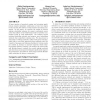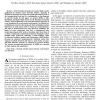101 search results - page 13 / 21 » LORD: A Localized, Reactive and Distributed Protocol for Nod... |
SASN
2006
ACM
14 years 1 months ago
2006
ACM
Wireless sensor networks are typically deployed to measure the information field, rather than create an information field. However, by utilizing the radio on sensor nodes, it is...
ANSS
2007
IEEE
14 years 2 months ago
2007
IEEE
Data propagation in wireless sensor networks is usually performed as a multihop process. To deliver a single message, the resources of many sensor nodes are used and a lot of ener...
MOBIHOC
2006
ACM
14 years 1 months ago
2006
ACM
A large number of practical sensing and actuating applications require immediate notification of rare but urgent events and also fast delivery of time sensitive actuation command...
ICASSP
2009
IEEE
14 years 2 months ago
2009
IEEE
We consider transmission scheduling by medium access control (MAC) protocols for energy limited wireless sensor networks (WSN) in order to maximize the network lifetime. Time-vary...
TWC
2008
13 years 7 months ago
2008
Event boundary detection is in and of itself a useful application in wireless sensor networks (WSNs). Typically, it includes the detection of a large-scale spatial phenomenon such ...


